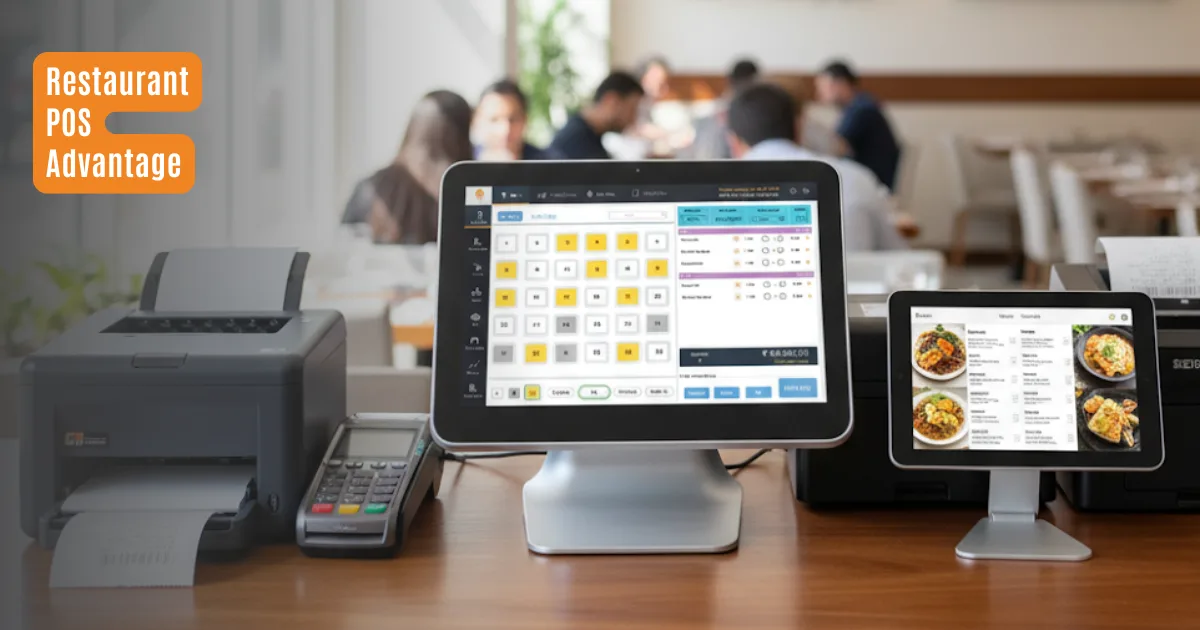Running a restaurant without the right POS system is like trying to cook without a recipe. You might get by for a while, but inefficiency and errors will catch up. Over the last decade, restaurant POS systems have evolved far beyond billing counters. Today, they work as the operational backbone of restaurants, managing everything from order accuracy and staff scheduling to customer loyalty and analytics.
In an industry where razor-thin margins meet rising customer expectations, the features of your restaurant POS system can make or break success. This guide explores the essential restaurant POS features for 2025, not just as tech add-ons, but as real solutions to the everyday challenges restaurateurs face.
Why POS Features Matter in 2025
Reportlinker projects the global restaurant POS system market to reach USD 20 billion by 2030—the rise of digital payments, online delivery, and customer demand for speed drives this growth. Diners today expect faster service, multiple payment options, personalised offers, and consistent experiences across dine-in, takeaway, and delivery.
Operators also struggle with:
- Frequent order errors and food waste reduce profit margins.
- Labour shortages and rising staffing costs.
- Fragmented data across outlets makes it hard to monitor performance.
Modern POS systems’ features directly tackle these pain points. They save time, reduce waste, improve staff efficiency, and support data-driven decisions that help restaurants grow.
Essential Restaurant POS Features
Here are 18 must-have restaurant POS system features for 2025. Each one is explained with the challenges it addresses, the benefits it offers, and real-world examples.
1. Real-Time Inventory Management
Benefits: Track stock levels live to cut waste and prevent shortages.
Challenges: Avoids over-ordering or running out of key ingredients during rush hours.
Example: An Italian bistro can monitor mozzarella usage in real time, ensuring an accurate and consistent supply.
2. Integrated Billing & Multi-Payment Modes
Benefits: Guests can pay using their preferred method, such as cards, UPI, wallets, or even Buy Now, Pay Later. The billing process is faster and more accurate.
Challenges: It eliminates manual calculation errors at checkout and avoids customer dissatisfaction caused by limited payment options.
Examples: A café can seamlessly let a group of friends split one bill across four different wallets, keeping the payment experience smooth.
3. Kitchen Order Ticket (KOT) Integration
Benefits: It ensures that every order goes straight from the server or POS to the kitchen without delays, keeping food accurate and service fast.
Challenges: Avoids mistakes that often happen with handwritten notes or verbal communication, especially during busy hours.
Example: At Bistro Delight, manager Daniel relies on KOT integration to keep things running smoothly. When server Emma enters an order into the POS, it prints instantly in the kitchen for Chef Maria with all special requests like “gluten-free base” or “extra cheese.” This eliminates confusion, reduces mistakes, and keeps service fast even during the dinner rush.
4. Table & Floor Management
Benefits: Helps restaurants manage reservations smoothly, seat guests faster, and turn tables quickly without keeping people waiting.
Challenges: Prevents the everyday chaos during peak hours when staff struggle to balance walk-ins with pre-booked tables.
Example: At Olive & Oak, manager Sophia uses a digital floor plan to see all tables at a glance. She assigns server Liam to Zone A and server Mia to Zone B, making sure walk-ins and reservations are seated without delay and staff aren’t stepping on each other’s toes.
5. Menu Engineering & Dynamic Pricing
Benefits: It helps restaurants determine which dishes sell the most and which ones don’t and adjust prices smartly to increase profits.
Challenges: Removes the guesswork from deciding what to keep, promote, or price differently on the menu.
Example: At Sunset Bar, owner Kareem uses dynamic pricing to offer discounted appetizers during happy hour, which draws more guests and boosts sales.
6. Digital Menu with Upselling Features
Benefits: Saves money on printing, keeps menus constantly updated, and increases sales by suggesting add-ons at the right time.
Challenges: Solves the problem of outdated paper menus and missed chances to recommend extra items.
Example: At Bella Pizzeria, owner Luca uses a digital menu that suggests “Add garlic bread for $2” when customers order pizza, increasing the average order value by around 15%.
7. Mobile Ordering & Captain App
Benefits: Let’s staff take orders quickly and accurately right at the table, improving speed and customer experience.
Challenges: It removes delays and mistakes that happen when handwritten orders are later entered into the POS.
Example: At Ocean Grill, server Aisha uses a captain app to place orders directly from the table, so dishes reach the kitchen instantly without errors or extra steps.
8. Delivery Partner Integration
Benefits: Brings all online orders from platforms like Swiggy, Zomato, and Uber Eats into one system, making operations faster and easier.
Challenges: Removes the hassle of switching between different dashboards and lowers the chance of missing or duplicating orders.
Example: At Curry Bowl, owner Hassan uses delivery partner integration to manage about 180 daily online orders from multiple apps in a single POS dashboard, keeping the kitchen and delivery teams in sync.
9. Cloud-Based Access & Data Security
Benefits: Let owners track sales and performance from anywhere with secure logins, while automatic backups keep data safe.
Challenges: Guards against system outages, data loss, or security breaches that could disrupt business.
Example: While travelling overseas, restaurant owner Nitin checks real-time sales from her smartphone through the cloud system, ensuring her outlets run smoothly even when he’s away.
10. Sales & Performance Analytics
Benefits: Shows which days and items bring in the most sales, tracks margins, and highlights shifts in customer demand.
Challenges: Removes guesswork from decision-making by giving owners precise, reliable data.
Example: At Brew & Bite, owner Maya discovers that Friday evenings bring a spike in dessert sales, so she launches targeted promotions to boost profits even further.
11. Employee Scheduling & Performance Tracking
Benefits: Helps managers create balanced shifts, control labor costs, and monitor staff performance.
Challenges: Prevent common issues like overstaffing during slow hours or paying unnecessary overtime.
Example: At Green Leaf Diner, manager Raj schedules his team smartly so the restaurant handles the dinner rush smoothly without overspending on extra staff.
12. CRM & Loyalty Programs
Benefits: Builds stronger customer relationships by sending personalised offers and rewarding frequent visitors.
Challenges: Avoids the drop in repeat business that happens when promotions feel too generic.
Example: At Daily Grind Café, owner Sarah runs a loyalty program where customers get a free drink on every sixth purchase, encouraging repeat visits and boosting loyalty.
13. Multi-Outlet Management
Benefits: Keeps menus, prices, and promotions consistent across all outlets while giving owners one place to view reports.
Challenges: Solves the difficulty of managing each location separately, which can be time-consuming and error-prone.
Example: At Spice Route, franchise owner Ashwin manages 10 branches and launches a city-wide discount campaign instantly through the system.
14. Customisable Tax & Discount Management
Benefits: Automatically applies the right taxes and seasonal discounts, saving time and ensuring accuracy.
Challenges: Prevents billing mistakes and reduces the risk of compliance issues.
Example: At Shubh Café, owner Raj sets the system to charge 5% GST for takeaway and 18% GST for dine-in orders, ensuring every bill is correct.
15. Offline Mode
Benefits: Allows billing and order management to continue smoothly even without internet connectivity.
Challenges: Prevents loss of sales and delays during network outages.
Example: At Tandoori Treats, owner Meera continues serving customers from her food truck in areas with poor network coverage, ensuring no orders are missed.
16. Barcode Scanning & Recipe Management
Benefits: Speeds up billing and helps maintain consistent portion sizes.
Challenges: Prevents long queues and ensures food quality stays uniform.
Example: At Bistro Delight, owner Ana scans dessert barcodes at checkout while the kitchen follows standard recipes to serve uniform cake slices every time.
17. Accounting Software Integration
Benefits: It connects the POS with accounting software like Tally or QuickBooks, making reporting faster and more accurate.
Challenges: Eliminates delays and mistakes from manual data entry.
Example: At The Corner Diner, owner Lucas automatically pulls daily sales reports into QuickBooks, saving time and avoiding errors.
18. Kitchen Display System (KDS) & Customer Feedback Tools
Benefits: KDS organizes kitchen orders efficiently, while feedback tools let restaurants capture customer satisfaction instantly.
Challenges: Reduce misplaced orders and ensure feedback is structured and actionable.
Example: At The Spice House, owner Aisha uses a KDS to manage lunch orders during peak hours, while digital receipts prompt customers for instant feedback to improve service.
Choosing the Right POS Features for Your Restaurant
Not every restaurant needs the same features. Align your POS system features with your business model:
- QSRs and Fast-Food Outlets: Focus on KOT integration, delivery platforms, and real-time inventory. Later, add loyalty programs and dynamic pricing.
- Fine Dining: Table management, CRM tools, and menu engineering are essential. Mobile ordering and analytics are useful add-ons.
- Cafés and Bakeries: Must-have features include billing, multiple payment options, and recipe management. Digital menus and feedback tools work well as enhancements.
- Food Trucks: Mobile POS and offline mode are critical. Delivery integration and loyalty programs can follow as you expand.
By matching the right POS system features to your format, you can avoid overinvesting and ensure your setup maximises efficiency and profitability.
Industry Trends to Watch
To future-proof your POS investment, keep an eye on these 2025 trends:
1. AI-Driven Upselling
AI-powered POS tools personalise upselling, boosting check sizes by 20–25% and increasing average orders by 22%.
2. Contactless Ordering
QR menus and digital payments are now mainstream. According to the National Restaurant Association, 75% of operators call them essential, and 70% of U.S. restaurants already offer QR payments. 75% of diners prefer QR menus over printed ones.
3. Sustainability Tracking
POS systems increasingly measure waste and eco-metrics. Studies confirm QR menus reduce paper waste and raise customer satisfaction, making them sustainable alternatives
4. Advanced Reporting & Predictive Analytics
Next-gen POS systems forecast sales and staffing needs. According to a Business Insight Research report, predictive analytics can cut inventory waste by 20% and support the restaurant automation market, which is projected to hit $17.2B by 2032.
Conclusion
A modern POS is no longer just a billing tool; it’s your restaurant’s digital brain. By carefully evaluating the essential POS features discussed above, you can cut errors, save costs, delight customers, and scale with confidence.
Before investing, assess which features align with your business type, growth plans, and customer base. Then, explore Devourin’s other POS resources and discover how the right restaurant POS system can transform your restaurant operations.
Author
-

With over 18 years of writing and editorial experience spanning lifestyle, hospitality, luxury, and corporate sectors, Radhika brings a seasoned perspective to content that informs, engages, and inspires.
At Devourin, Radhika combines deep industry insight with editorial precision to produce content that not only reflects the evolving needs of the food and restaurant industry but also drives connection, clarity, and growth.
Throughout her career, Radhika has written for leading brands and platforms. She is also the founder of KathaCraft, a boutique content studio focused on purposeful storytelling across diverse mediums.
Profile: LinkedIn


